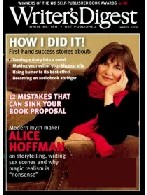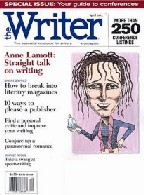Writing a novel in a year, with a few hours each weekend
![ha-ha-ha [Manic laughter.] Official NaNoWriMo 2005 Winner](../img/2005_nanowrimo_winner_icon.jpg)
|
Writer's Bill of Rights includes the rights to:
 Begin without a plot. Begin without a plot.
 Begin without characters. Begin without characters.
 Not finish. Not finish.
 Not defend your tastes. Not defend your tastes.
|  log of books read
log of books read
|
See also the pages on the project to write a 50,000-word novel in
November - National Novel Writing Month:
The Weekend Novelist Writes a Mystery
This book helps you:
- Focus on first things first: who is the Killer?
- Think scenically.
- Establish back story.
- Think structurally, yet not be overwhelmed by it.
The chapter headings from
The Weekend Novelist Writes a Mystery
give you an idea of the benefit of this guide book, which plunges you into the heart of your mystery,
and helps you understand it from the start:
| Weekends.
| Emphasis.
| Weekend-by-weekend.
|
| 1-4
| Character Work.
|
|
| 5-9
| Plotting.
|
|
| 10-13
| Scene Building.
|
| 10. Crime Scene Dialog.
| 11. Dialog.
| 12. Action.
| 13. Setting.
|
|
| 14-25
| First Draft.
|
| 14-17. Act One.
| 18-22. Act Two.
| 23-25. Act Three.
|
|
| 26-38
| Second Draft.
|
| 26-29. Rewriting Act One.
| 30-35. Rewriting Act Two.
| 36-38. Rewriting Act Three.
|
|
| 39-52
| Final Draft.
|
|
Other highlights:
Character-work Exercises in The Weekend Novelist Writes a Mystery
include:
- For the Killer:
- Interview your killer.
- Make a character sketch to organize what you know.
- Murder checklist: place, time, lighting, weapon, wounds, season and weather,
wardrobe, planning, disposal of body.
- Make a few scene cards. You'll be able to shuffle their order,
interleaving with scenes for other characters, etc.
- For the Victim:
- Write your victim's interior monologue: "I remember ...".
- Make a character sketch to organize what you know.
- Connection of victim to the killer.
- Steps to the murder: use narrative and internal dialog to
show the victim's experience and emotions just before meeting the killer.
Then show some of their dialog.
- Make a few scene cards. May include interviews that show the suspect's past.
- For the Sleuth, who is "your persona, the face you choose to present to the world, ...
It saves time if you replicate some of your own traits when you create your sleuth":
- Back story: write a couple of pages of "specific ... events connected to the story that took
place in the past before the book opens".
- Make "half a dozen scene cards that define the sleuth at different
stages of the book". Include cards for the crime scene,
the recreation of the crime, first encounter of sleuth with the
killer,
visit to the
victim's environment,
confrontation with the
killer,
and the sleuth's reward for effort (money? power? praise? love? glory? or what?).
- Make a character sketch to organize what you know.
- Dialog of the sleuth to start hearing voice.
- A Catalyst should:
- Connect to other main character(s) through the back story.
- Connect to the resource base (such as the MacGuffin).
- Help with the plot.
For your Catalyst:
- List the connection of your catalyst (or for each of a pair of potential catalysts)
to your killer,
victim, and
sleuth.
- Explore the catalyst's connection to the resource base.
This brings out some of the motivation.
- Make a character sketch to organize what you know.
- Make scene cards for entrances and interactions of the catalyst.
Plotting Exercises in The Weekend Novelist Writes a Mystery include:
- For Back Story, develop:
- Back-story checklist (for crime, motive, and method)
by means of the questions supplied in the book.
- Chronology of checklist material.
- Narrative summary of major events in the back story,
identifying cause-effect relationships.
- Key Scenes form the framework of your mystery novel,
which can be divided into three acts (the classic beginning, middle, and end).
Make:
- 6 cards labeled 'opener', 'plot point 1' ,
'midpoint', 'plot point 2', climax, and wrap-up.
Fill in the cards from your back story.
Can include setting, objects, action, motive.
- A diagram of the action, based on the scene cards and
back story.
- A narrative summary paragraph for each key scene.
- For Plot Picture-Diagram.
- Draw the plot picture as a rising line quartered by Act One, the two halves of Act Two, and Act Three.
Add bubbles with character names; show where major and minor characters enter and where major characters
leave the story (e.g., die).
- Generate a new scene card whenever a character enters your story.
- Write some paragraphs about what you see in your plot picture. It's the beginning of a
synopsis. But at this stage it can be simply observations on what needs work,
such as overcrowding, excessive delay in bringing the killer on scene, etc.
- For Subplots.
- For Working Synopsis.
Other snippets:
- [p. 95.] Today's average length for a mystery novel is 75,000-80,000 words.
- [p. 95.] For a 300-page book, Act One peaks and ends about page 75 (quarter way in)
while Act Two (with a midpoint) takes about 150 pages.
The book recommends these books as models and guides; the stars are for my preferences
and the blue balls are for my least recommended:
- Becker, Ernest, Escape from Evil.
- Christie, Agatha, Autobiography.
- Cawleti, John, Adventure, Mystery, and Romance.
- Gill, Gillian, Agatha Christie: The Woman and her Mystery.
- Morgan, Janet, Biography of Agatha Christie.

 Novel by Chandler, Raymond, The Big Sleep.
Novel by Chandler, Raymond, The Big Sleep.
- [OK.] Novel by Christie, Agatha,
The Body in the Library (1941).
- [OK.] Novel by Cornwell, Patricia,
All That Remains.
 Novel by Grafton, Sue,
"F" is for Fugitive (1989).
Novel by Grafton, Sue,
"F" is for Fugitive (1989).
 Novel by Harris, Thomas, The Silence of the Lambs.
Novel by Harris, Thomas, The Silence of the Lambs.
 Novel by Smith, Martin Cruz,
Gorky Park (1981).
Novel by Smith, Martin Cruz,
Gorky Park (1981).
The Weekend Novelist

The Weekend Novelist.
|
This book helps you to write a novel in a year of weekends.
The chapter headings from
The Weekend Novelist
show the benefit of this guide book:
| Weekends.
| Emphasis.
| Weekend-by-weekend.
|
| Throughout the year.
| Warming up and writing tips.
|
|
| 1-4
| Character Work.
|
| 1. Character sketch.
| 2. Back Story.
| 3. Dream.
| 4. Dressing your characters.
|
|
| 5-10
| Scene Building.
|
| 5. Scene Analysis or Sketch.
| 6. Stage Setup.
| 7. Dialogue.
| 8. Action.
| 9. Point of View.
| 10. Building Chapters
|
|
| 11-14
| Plotting.
|
| 11. Key Scenes.
| 12. Aristotle's 3-part structure of rising intensity.
| 13. Story Line.
| 14. Scenario.
|
|
| 15-20
| Writing your key scenes
|
| 15. Opening Scene.
| 16. Wrapup Scene.
| 17. Catharsis Scene.
| 18. Scene at Midpoint.
| 19. Scene at Plot Point One.
| 20. Scene at Plot Point Two.
|
|
| 21-31
| Writing the Discovery Draft.
|
| 21-23. Act One.
| 24-28. Act Two.
| 29-31. Act Three.
|
|
| 32-45
| Writing the Meditation Draft.
|
| 32-34. Deepening Key Scenes.
| 35-45. Acts One, Two, and Three.
| 35-37. Act One.
| 38-42. Act Two.
| 43-45. Act Three.
|
|
| 46-52
| Final Draft.
|
| 46. Reading.
| 47. Cutting.
| 48-51. Rewriting.
| 52. Editing.
|
|
The book recommends these books as models and guides; the stars are for my preferences:

 Burroway, Janet, Writing Fiction.
Burroway, Janet, Writing Fiction.
- Gardner, John, The Art of Fiction.
- Hall, Oakley, The Art and Craft of Novel Writing.
- Novel by Fitzgerald, F. Scott, The Great Gatsby.
- Novel by Hemingway, Ernest, The Sun Also Rises.
- Novel by Tyler, Anne, The Accidental Tourist.
- Structural advice by Campbell, Joseph, The Hero with a Thousand Faces.
- Structural advice by Field, Syd, Screenplay
and The Screenwriter's Workbook.
- Structural advice by Murdock, Maureen, The Heroine's Journey.
 Begin without a plot.
Begin without a plot.
 Begin without characters.
Begin without characters.
 Not finish.
Not finish.
 Not defend your tastes.
Not defend your tastes.
 log of books read
log of books read
 Begin without a plot.
Begin without a plot.
 Begin without characters.
Begin without characters.
 Not finish.
Not finish.
 Not defend your tastes.
Not defend your tastes.
 log of books read
log of books read






 Novel by Chandler, Raymond, The Big Sleep.
Novel by Chandler, Raymond, The Big Sleep.
 Novel by Grafton, Sue,
"F" is for Fugitive (1989).
Novel by Grafton, Sue,
"F" is for Fugitive (1989).
 Novel by Harris, Thomas, The Silence of the Lambs.
Novel by Harris, Thomas, The Silence of the Lambs.
 Novel by Smith, Martin Cruz,
Gorky Park (1981).
Novel by Smith, Martin Cruz,
Gorky Park (1981).


 Burroway, Janet, Writing Fiction.
Burroway, Janet, Writing Fiction.